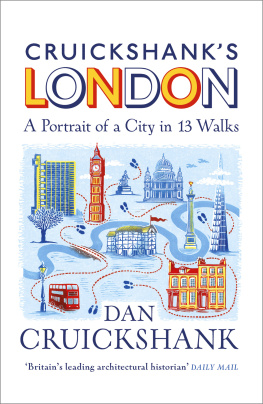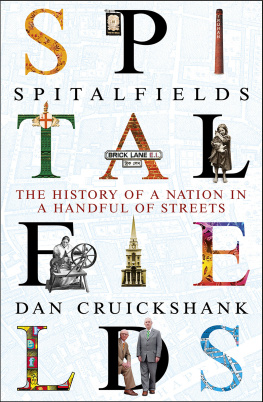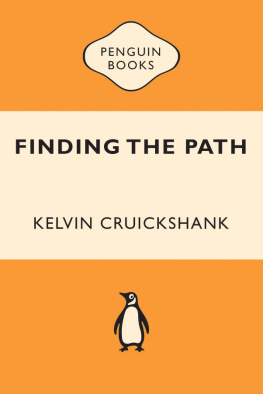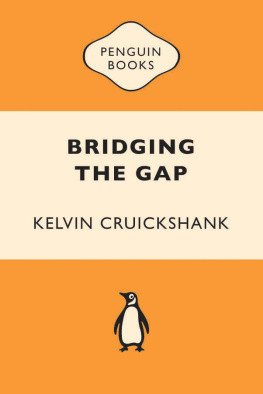Dan Cruickshank - Cruickshanks London
Here you can read online Dan Cruickshank - Cruickshanks London full text of the book (entire story) in english for free. Download pdf and epub, get meaning, cover and reviews about this ebook. year: 2019, publisher: Random House, genre: Romance novel. Description of the work, (preface) as well as reviews are available. Best literature library LitArk.com created for fans of good reading and offers a wide selection of genres:
Romance novel
Science fiction
Adventure
Detective
Science
History
Home and family
Prose
Art
Politics
Computer
Non-fiction
Religion
Business
Children
Humor
Choose a favorite category and find really read worthwhile books. Enjoy immersion in the world of imagination, feel the emotions of the characters or learn something new for yourself, make an fascinating discovery.
- Book:Cruickshanks London
- Author:
- Publisher:Random House
- Genre:
- Year:2019
- Rating:3 / 5
- Favourites:Add to favourites
- Your mark:
- 60
- 1
- 2
- 3
- 4
- 5
Cruickshanks London: summary, description and annotation
We offer to read an annotation, description, summary or preface (depends on what the author of the book "Cruickshanks London" wrote himself). If you haven't found the necessary information about the book — write in the comments, we will try to find it.
Cruickshanks London — read online for free the complete book (whole text) full work
Below is the text of the book, divided by pages. System saving the place of the last page read, allows you to conveniently read the book "Cruickshanks London" online for free, without having to search again every time where you left off. Put a bookmark, and you can go to the page where you finished reading at any time.
Font size:
Interval:
Bookmark:


A few metres west of Bank station in the City lies one of the most ancient and sacred sites in London. The junction of Threadneedle Street and Poultry marks the course of the Walbrook a small river that flowed from the north-east into the Thames. In Roman times, this was regarded as a holy place, where sacrifices were made to the gods. In those days, it meandered about 7 metres below existing ground level; by the sixteenth century it ran in subterranean culverts, and by the mid nineteenth century its water was appropriated to help flush out Londons new sewer system and the Walbrook was all but lost.
But the of the Walbrook that remain tell us much about the ancient history of London. Its route marked a key division in the Roman City. The land to the west of the river was, in the early years, generally informally built upon, with large areas left open to serve as gardens and paddocks; to the east was a grid of streets, more densely built upon, and the location of major public or institutional buildings such as the forum and the governors palace.
This was Londinium, founded in the late 40s AD . In 55 and 54 BC Julius Caesar had invaded Britain, the second time with five legions, and, marching north from Kent, crossed the Thames, subdued British tribes, established client kings subservient to Rome, established a system of tributes to be paid to Rome and then withdrew. But in AD 43 Rome mounted a full-scale invasion as a prelude to occupation, ostensibly to quell growing turmoil in Britain that threatened the payment of tribute, though also no doubt to secure undisturbed access to valuable resources such as tin.
Emperor Claudius sent four legions across the Channel, one of which II Augusta was commanded by the future emperor Vespasian. By the mid first century, much of what is now southern England had been conquered. And, over the course of the next century, Londinium was to become the largest city in the Roman colony of Britannia becoming the of the province soon after AD 61, following the suppression of Boudiccas uprising.
In the years that followed, the Walbrook would become a river of great importance. The City of Londons wall was completed between AD 190 and 225, and, as the built area of London expanded within it during the second, third and fourth centuries, the marshy banks of the shallow and meandering Walbrook were reclaimed and wharves and manufactories built along its western side. This small river, then, came to serve as a key location on the sea and river trade route linking Britain with continental Europe.
Today, the clearest signs of the old course of the Walbrook are around a huge late-modern building which houses the financial services empire Bloomberg. It is memorialised in direct and conventional manner, in a piece of public art that embellishes the buildings Queen Victoria Street frontage. As a work of public art it is better than most, being very site specific and extremely evocative. Entitled Forgotten Streams and created by the Spanish artist Cristina Iglesias, the work shows in several sections large and very lifelike portions of river bed and marshy bank, packed with entwined roots and through which tumble small courses of water, as in a cascade. Bank and bed are made of bronze with the roots and plant tendrils being most delicately wrought.
 The Walbrook in bronze: Cristina Iglesiass Forgotten Streams marks the course of the lost river.
The Walbrook in bronze: Cristina Iglesiass Forgotten Streams marks the course of the lost river. The most exciting legacy of the Walbrook, however, lies underground. For in Roman times the river banks hosted not only quays and factories, but also a temple to the god Mithras. Built on of the reclaimed east bank of the Walbrook in the mid third century AD , the site was probably chosen because this small river was marshy and so was perceived as equivalent to the River Styx, the mythological river that marked the boundary between the Earth and the Underworld and joined other rivers, such as the Acheron, at a great marsh at the centre of the Underworld. Extraordinarily, this temple can still be seen today, in a dedicated museum underneath the Bloomberg building. The Mithraeum has been reconstructed almost on the original site and as far as possible to its original orientation, having been disassembled and relocated after its discovery in the 1950s. It is a triumph, returning to London an incredibly important and thought-provoking building from the Roman world, with an appropriate sense of respect, scholarship, awe and healthy theatricality.
Any visit to the Mithraeum by booking only, but free offers a tantalising glimpse of the idiosyncrasies of the Roman faith. For Mithras is a Persian god, whose veneration became popular in the Roman empire during the AD first century and with a life history and attributes strikingly similar to Christ. Some of this history is speculative, due to lack of firm knowledge from the ancient world about Mithras it was, after all, a secretive mystery cult open only to initiates. But it seems that both Mithras and Christ were born on 25 December, both offered their followers salvation (paid for by a sacrifice of holy blood), and in both religions the cross was sacred. Mithras, too, appears to have undergone some form of epiphany or rebirth in a cave, comparable to Christs resurrection in his tomb after crucifixion. Did early Christians borrow from the mystery cult of Mithras? Perhaps, but its more likely that the initiates of Mithras borrowed from early Christian rituals.
Such a mingling of traditions was possible because Roman religion was generally tolerant and inclusive: foreign gods were easily accommodated and often renamed to make them more Roman. Baal, the great creator God of the Middle East, was simply adopted by the Romans and his images and temples renamed in honour of Jupiter. This tradition of relaxed inclusiveness meant that the Romans were initially baffled and then infuriated when confronted by the monotheistic Jews and Christians who would not tolerate the existence of any gods but their own. Naturally the tolerant pagans become increasingly put out by the stridently intolerant monotheists, and thus Christianity was criminalised and its followers came to be regarded as members of a riotous, antisocial and anarchic cult and were punished in the manner of all such criminals. Christians called the punishment persecution; the Romans no doubt saw it merely as justice.
The modern-day atmosphere of the Mithraeum, now dark and deep underground, is an apt recreation of the original temple. Mithras was worshipped in dark and secure places no doubt to commemorate his epiphany within a cave and with much ritual. The initiates had to undergo various secret ceremonies, some more or less frightening. There were likely seven grades of initiates, who acknowledged one another by means of secret handshakes. This was probably a male-only affair no evidence of female initiates has been found and through its mystery and initiations, the cult must have forged bonds and a sense of brotherhood, especially between legionaries serving on the hostile edges of the known world, such as Roman Londinium.
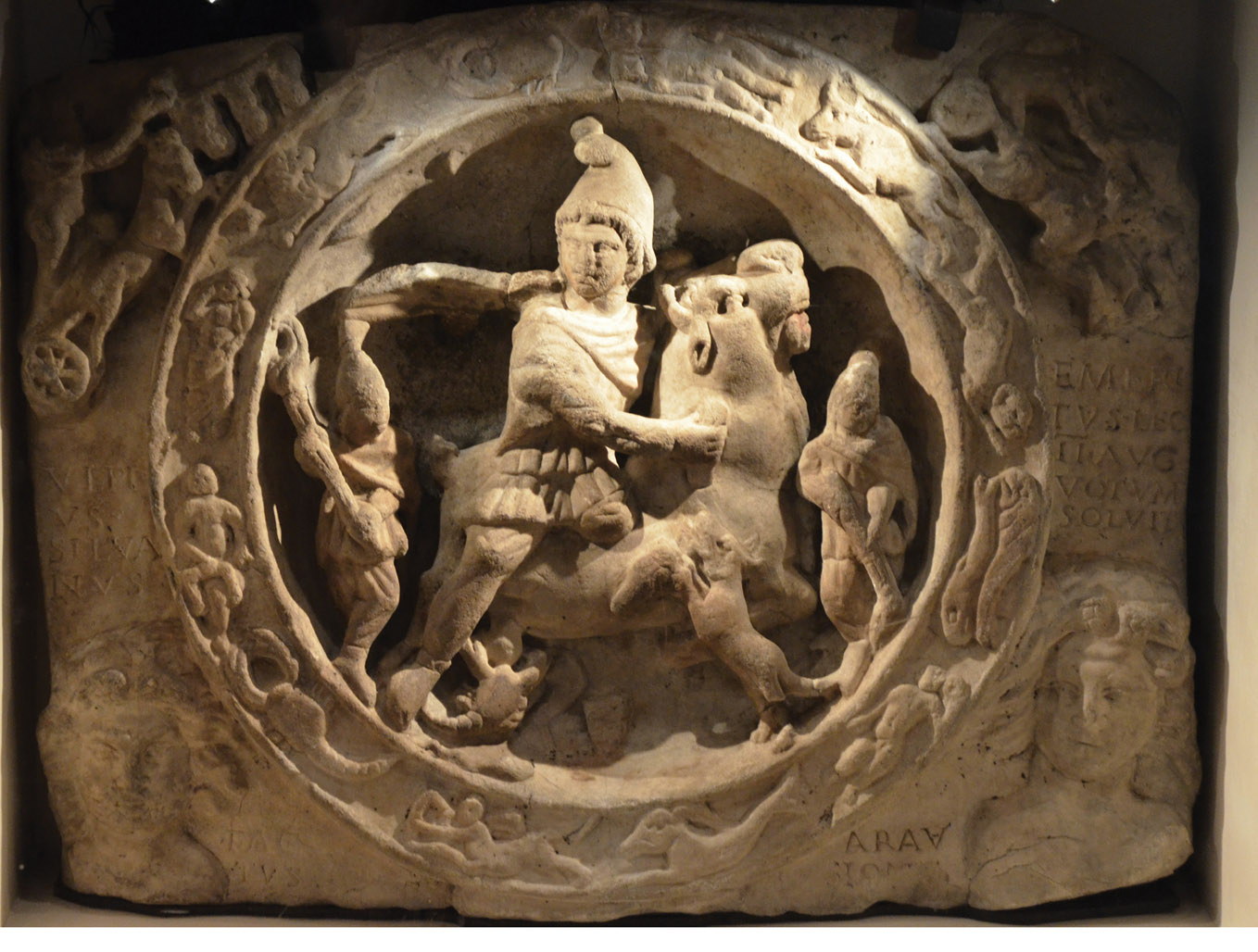 The relief of Mithras slaying the astral bull, now in the Museum of London.
The relief of Mithras slaying the astral bull, now in the Museum of London. What we know about the cult of Mithras has largely been gleaned from a few surviving artefacts and inscriptions found at different sites. At the heart of this Mithraeum as was presumably typical would once have been a relief, now preserved nearby in the Museum of London, but partially evoked on glass inside the current temple. It shows Mithras slaying the astral bull, an act of sacrifice that maintained the cosmic and controlled the fates of man. On the relief Mithras the central figure wearing a Phrygian bonnet is surrounded by a ring emblazoned with the signs of the zodiac. So Mithras was perceived as being at the centre of the cosmic wheel of the zodiac, which turned remorselessly through the year. Devotees believed that it was through the power and influence of the stars and planets that the gods ordered the lives of man.
Next pageFont size:
Interval:
Bookmark:
Similar books «Cruickshanks London»
Look at similar books to Cruickshanks London. We have selected literature similar in name and meaning in the hope of providing readers with more options to find new, interesting, not yet read works.
Discussion, reviews of the book Cruickshanks London and just readers' own opinions. Leave your comments, write what you think about the work, its meaning or the main characters. Specify what exactly you liked and what you didn't like, and why you think so.

